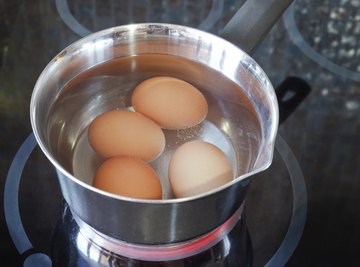
Sometimes called the fourth state of matter, plasma consists of ionized gas wherein one or more electrons aren't bound to a molecule or atom. You may never observe such an exotic substance, but you encounter solids, liquids and gases daily. Many factors affect which of these states matter exists in.
Intermolecular Forces at Work
Atoms, matter's basic building blocks, combine to create molecules such as water. Intermolecular forces (IMF) between molecules help determine a substance's phase. When the IMF is weak, a substance is usually a gas when the atmospheric pressure is 1 atm (a unit of standard atmospheric pressure) and the temperature is 25 degrees Celsius (77 Fahrenheit). Conversely, the substance will probably be a solid at that same pressure and temperature when the IMF is strong.
Solids, Liquids, Gases and Particles
Different phases of matter behave in unique ways. In a solid, attraction between particles is greater than their energy of motion -- particles are also close. Particles in liquids are close but their energy of motion and attraction are about the same. Finally, gas particles are far apart and their energy of attraction is less than their energy of motion.
Phase Transitions
Temperature, pressure and a substance's composition affect the way it changes phases. A phase diagram shows the phases that different substances assume at various temperatures and pressures. Vaporization, condensation, sublimation, deposition, freezing, and melting are some of the ways phase changes occur. Vaporization happens when liquid turns to gas, while condensation describes the process in which gas turns back into liquid. When water evaporates, vaporization occurs, and water vapor can return to the liquid state by condensing. Some substances, such as solid carbon dioxide (dry ice) can pass directly from the solid state to the gas state -- scientists call this sublimation. Deposition is the opposite process -- a gas bypasses the liquid state and changes into a solid. Freezing is changing from liquid to solid, and melting is changing from solid to liquid.
Phase Differences
A substance may transition from liquid to gas by boiling, from liquid to solid by freezing, and from solid to liquid by melting. Ice, liquid water and water vapor may consist of the same molecules, but they differ in several important ways. For example, it's difficult to compress a solid or liquid to a large degree, but you can easily compress a gas. Liquids and gases assume the shape of their containers, but solids do not. Gases have an additional ability to expand when they assume a container's shape and match the container's volume.
References
- General Chemistry; William Vining, Young, Roberta Day, Beatrice Botch
- Let's Review - Physics - The Physical Setting; Miriam A. Lazar
- Dixie State University: States of Matter
- University of Missouri-Kansas City: Liquids, Solids and Phase Changes
- Chemistry: Principles and Practice; Daniel Reger, Scott Goode, David Ball
- Plasma Chemistry; Alexander Fridman
About the Author
After majoring in physics, Kevin Lee began writing professionally in 1989 when, as a software developer, he also created technical articles for the Johnson Space Center. Today this urban Texas cowboy continues to crank out high-quality software as well as non-technical articles covering a multitude of diverse topics ranging from gaming to current affairs.
Photo Credits
VvoeVale/iStock/Getty Images
